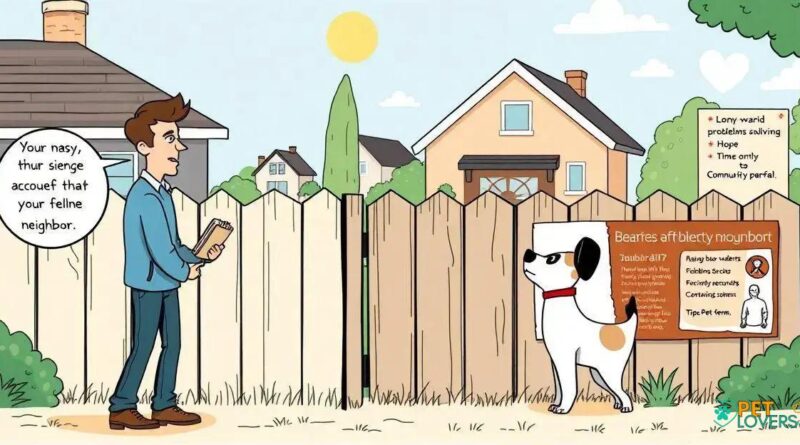What to Do When the Neighbor’s Dog is a Nuisance: Tips and Solutions
If you’re dealing with a nuisance dog in your neighborhood, start by identifying the specific issues and communicating clearly with your neighbor. Keep a record of incidents and, if needed, involve local authorities. Collaborate with your neighbor to address the dog’s behavior and consider implementing physical barriers or deterrents to minimize disturbances. By taking these steps, you can effectively resolve the situation and restore peace in your living environment.
Are you tired of dealing with the constant barking, digging, or trespassing of your neighbor’s dog? If so, you’re not alone. Many homeowners face similar issues with their neighbor’s pets, but it’s essential to know what to do when the neighbor’s dog is a nuisance.
In this article, we’ll explore the common problems associated with a neighbor’s dog being a nuisance and provide tips and solutions to help you resolve the issue.
Understanding the Problem: Identifying the Issues with the Neighbor’s Dog
The first step in addressing a nuisance dog is to identify the specific issues you’re experiencing. This may include constant barking, digging, trespassing, or other unwanted behaviors. Keep a journal or log to track the incidents, noting the date, time, location, and nature of the problem. This will help you understand the patterns and triggers of the dog’s behavior, making it easier to develop a plan to address the issue.
Effective communication is key to resolving the issue of a nuisance dog. Start by talking to your neighbor in a calm and respectful manner, explaining the impact of the dog’s behavior on you and your family. Be specific about the problems you’re experiencing and avoid blaming or attacking your neighbor. Offer solutions and suggestions for addressing the issue, and be open to compromise and finding a mutually beneficial solution.
It’s essential to keep a record of incidents involving the nuisance dog, including dates, times, locations, and descriptions of the behavior. This documentation can be used to support your claims if the issue escalates and you need to seek help from local authorities. Take photos or videos of the incidents, and keep a record of any conversations with your neighbor or other witnesses.
If talking to your neighbor doesn’t resolve the issue, you may need to seek help from local authorities. Start by contacting your local animal control agency or police department to report the problem. They can provide guidance on the appropriate course of action and help you develop a plan to address the issue. Be prepared to provide evidence of the incidents, including your documentation and any witness statements.
To prevent future incidents, it’s essential to develop a long-term plan to address the issue. This may involve working with your neighbor to implement changes to the dog’s behavior, such as training or behavioral modification. You may also need to consider implementing physical barriers or other deterrents to prevent the dog from entering your property. By working together, you and your neighbor can create a nuisance-free neighborhood for everyone’s benefit.
Communicating with the Neighbor: Effective Ways to Resolve the Issue
The first step in addressing a nuisance dog is to identify the specific issues you’re experiencing. This may include constant barking, digging, trespassing, or other unwanted behaviors. Keep a journal or log to track the incidents, noting the date, time, location, and nature of the problem. This will help you understand the patterns and triggers of the dog’s behavior, making it easier to develop a plan to address the issue.
Documenting Incidents: Keeping a Record of the Dog’s Behavior
Keeping a record of incidents involving the nuisance dog is crucial for several reasons. Firstly, it helps you to track the behavior and identify patterns, which can inform your approach to addressing the issue.
Secondly, it provides evidence of the problem, which can be useful if you need to seek help from local authorities.
Thirdly, it helps you to stay organized and focused, which can reduce stress and anxiety.
To document incidents, take notes on the date, time, location, and nature of the problem. You can also include photos or videos, as well as witness statements and any relevant documentation.
By keeping a detailed record of incidents, you can develop a comprehensive understanding of the problem and create a plan to address it.
Seeking Help: How to File a Complaint with Local Authorities
If talking to your neighbor doesn’t resolve the issue, you may need to seek help from local authorities. Start by contacting your local animal control agency or police department to report the problem. They can provide guidance on the appropriate course of action and help you develop a plan to address the issue.
Be prepared to provide evidence of the incidents, including your documentation and any witness statements. Additionally, you can also file a complaint with local authorities, who can take enforcement action if necessary.
It’s essential to stay calm and professional when seeking help, as this will help to ensure that your concerns are taken seriously and that you receive the assistance you need.
Preventing Future Incidents: Long-Term Solutions for a Nuisance-Free Neighborhood
Preventing future incidents requires a long-term approach that involves working with your neighbor to implement changes to the dog’s behavior. This may include training or behavioral modification, as well as creating physical barriers or other deterrents to prevent the dog from entering your property.
Additionally, you may need to consider implementing noise-reducing measures, such as soundproofing your home or installing a white noise machine. By working together with your neighbor, you can develop a comprehensive plan to prevent future incidents and create a nuisance-free neighborhood for everyone’s benefit.
By understanding the problem, communicating effectively with your neighbor, documenting incidents, seeking help when needed, and preventing future incidents, you can successfully address the issue of a nuisance dog in your neighborhood.
Remember to stay calm and professional throughout the process, and don’t hesitate to seek help if you need it.
With persistence and patience, you can resolve the issue and enjoy a peaceful and enjoyable living environment.
FAQ – Frequently Asked Questions about Nuisance Dogs
What should I do if my neighbor’s dog is a nuisance?
First, try to communicate with your neighbor and explain the impact of the dog’s behavior on you and your family. If that doesn’t work, consider documenting incidents and seeking help from local authorities.
How can I document incidents involving my neighbor’s dog?
Keep a record of incidents, including dates, times, locations, and descriptions of the behavior. Take photos or videos, and keep a record of any witness statements.
What if talking to my neighbor doesn’t resolve the issue?
If talking to your neighbor doesn’t resolve the issue, consider seeking help from local authorities. They can provide guidance on the appropriate course of action and help you develop a plan to address the issue.
How can I prevent future incidents with my neighbor’s dog?
Work with your neighbor to implement changes to the dog’s behavior, such as training or behavioral modification. Consider creating physical barriers or other deterrents to prevent the dog from entering your property.
What if I need to file a complaint with local authorities?
Be prepared to provide evidence of the incidents, including your documentation and any witness statements. Stay calm and professional when seeking help, and don’t hesitate to seek assistance if you need it.
How can I resolve the issue of a nuisance dog in my neighborhood?
By understanding the problem, communicating effectively with your neighbor, documenting incidents, seeking help when needed, and preventing future incidents, you can successfully address the issue and enjoy a peaceful and enjoyable living environment.





